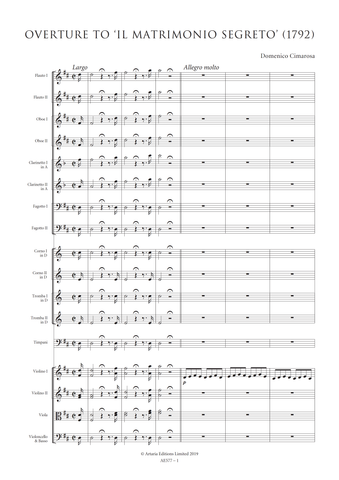Description |
Cimarosa, Domenico (1749-1801)
|
||||||||||||||||
Audio sample |
|||||||||||||||||
Details |
Domenico Cimarosa was commissioned to write an opera buffa for the Carnival season of 1786 by Naples' Teatro Nuovo. He turned to the poetlibrettist Giuseppe Diodati with whom he had worked on his Il capriccio drammatico of 1781 . Diodati created a two-act comedy, Il credulo (The Gullible One), which tells of the plight of a gentleman who is attempting to marry off his daughter to a gullible gentleman from Naples, a plot which centres around a jealous lover who plans to thwart the wedding by spreading the rumour that the young lady, the would be bride, has gone insane. Scheduled as the third opera of the 1786 Carnival season, at which time this two-act work was coupled with Cimarosa's one-act comedy L'impresario in angustie (The Impresario in Distress), it was apparently so well received that it was rescheduled as the 'fourth' opera of the same season, this time coupled with Cimarosa's one-act comedy, La baronessa Stramba. As with all successful operas of the era, Il credulo went on to play in other cities, sometimes in a Cimarosarevised version in one act, and sometimes titled Il credulo delusa (The Deluded Gullible One). The record of performances of Il credulo - the 45th of Cimarosa's more than 65 operas - includes Rome (1787), Florence (1789), Barcelona (1788 and 1789),Modena (1791), St Petersburg (1794), Naples again (1795), Lisbon (1797) and Venice (1800). Its last performance of record was a revival in Naples as the opening opera of the 1808 season at Teatro San Ferdinando.While there are a number of 18th-century MS copies of the opera neither the entire opera not excerpts from it (including the overture) have been published to date. This edition is based on the composer's holograph score which is preserved in the library of the Conservatorio di music 'S Pietro a Majella', Naples, under the shelfmark Rari 1-2-11. As is the case with all Cimarosa's autograph material the overture to Il credulo shows signs of having been composed at breakneck speed. Every conceivable notational shortcut is taken and his placement of articulation and dynamic markings is erratic. It has been necessary, therefore, to frequently interpret the composer's intentions and even at times to impose an editorial solution where his own thoughts are not clear. In making sense of Cimarosa's score the style and notation of articulation and dynamic markings have been largely standardised throughout, and, where missing, markings have been reconstructed from parallel passages. These are indicated by the use of dotted slurs or brackets where appropriate. Obvious wrong notes have been corrected without comment; editorial emendations with no authority from the source are placed within brackets. Nick Rossi |
Loading...
Error














